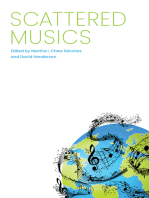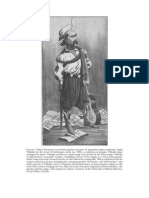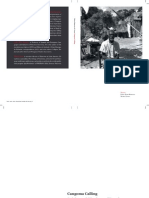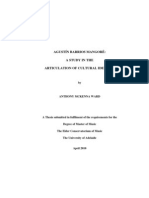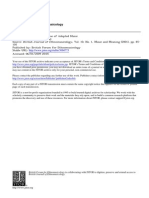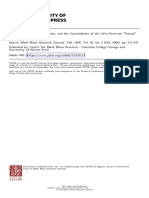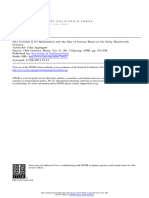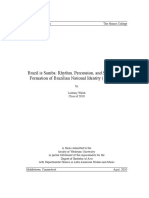Professional Documents
Culture Documents
University of Texas Press
University of Texas Press
Uploaded by
Wellington NascimentoOriginal Description:
Original Title
Copyright
Available Formats
Share this document
Did you find this document useful?
Is this content inappropriate?
Report this DocumentCopyright:
Available Formats
University of Texas Press
University of Texas Press
Uploaded by
Wellington NascimentoCopyright:
Available Formats
Choro: A Social History of a Brazilian Popular Music.
2005 by Tamara Elena Livingston-
Isenhour; Thomas George Caracas Garcia
Review by: Daniel Sharp
Latin American Music Review / Revista de Música Latinoamericana, Vol. 29, No. 1 (Spring -
Summer, 2008), pp. 96-99
Published by: University of Texas Press
Stable URL: http://www.jstor.org/stable/29739146 .
Accessed: 12/06/2014 23:02
Your use of the JSTOR archive indicates your acceptance of the Terms & Conditions of Use, available at .
http://www.jstor.org/page/info/about/policies/terms.jsp
.
JSTOR is a not-for-profit service that helps scholars, researchers, and students discover, use, and build upon a wide range of
content in a trusted digital archive. We use information technology and tools to increase productivity and facilitate new forms
of scholarship. For more information about JSTOR, please contact [email protected].
University of Texas Press is collaborating with JSTOR to digitize, preserve and extend access to Latin
American Music Review / Revista de Música Latinoamericana.
http://www.jstor.org
This content downloaded from 194.29.185.230 on Thu, 12 Jun 2014 23:02:44 PM
All use subject to JSTOR Terms and Conditions
Reviews
TAMARA ELENA LIVINGSTON-ISENHOUR and THOMAS GEORGE CARACAS
garcia. Choro: A Social History of a Brazilian Popular Music. 2005.
Bloomington and Indianapolis: Indiana University Press.
Brazilian choro shares much with itsmore markedly Afro-Brazilian relative
samba, which eclipses the largely instrumental genre in the national and
international spotlight. Both begin to emerge during the Brazilian belle
?poque, their respective mixtures of African and European musical ele?
ments celebrated by the New Republic in the 1930s as representative of the
nation's foundational racial and cultural mixture. Choro: A Social History of
a Brazilian Popular Music by Tamara Elena Livingston-1senhour and Thomas
George aims to correct choro's underrepresentation
Caracas Garcia in the
English-language literature by examining choro performance practice in
the shifting context of nineteenth- and twentieth-century Brazil.
Choro occupies much of the same historical terrain covered by recent
samba scholarship, including The Mystery of Samba by Hermano Vianna
and Feiti?o Decente by Carlos Sandroni. Vianna's and Sandroni's books are
useful to assign together in a seminar on Latin American music because
they complement each other. Vianna's book is a historical work written by
an anthropologist focusing on salient issues surrounding popular music,
racial mixture, social class and modernist nationalism broadly spanning
the last two centuries. Sandroni is an ethnomusicologist, guitarist and
composer who is well versed in historical musicology. His book focuses on
the pivotal years in the development of the samba, 1917-1931, as he exam?
ines how the issues discussed by Vianna mentioned above affect samba's
musical details as the style crystallizes as amusical emblem of the Brazil?
ian nation.
Instead of publishing separate books readable in tandem like Vianna
and Sandroni, Thomas Garcia and Tamara Elena Livingston-Isenhour, a
PhD in performance practice and an ethnomusicologist, respectively, de?
cided to coauthor Choro, combining their work on these familiar themes of
popular music, race, class, and Brazilian modernism. Both guitarists who
admire Villa-Lobos, Garcia and Livingston-Isenhour joined forces after dis?
covering the extent to which their research dovetailed. Garcia wrote his
dissertation on the history of the choro from the 1870s to the 1950s, and
Livingston-Isenhour focused on the choro revival from the 1970s until the
present. The resulting book is an ambitious mixture of broad social history,
Latin American Music Review, Volume 29, Number 1, Spring/Summer 2008
? 2008 by the University of Texas Press, P.O. Box 7819, Austin, TX 78713-7819
This content downloaded from 194.29.185.230 on Thu, 12 Jun 2014 23:02:44 PM
All use subject to JSTOR Terms and Conditions
Reviews ? 97
detailed analysis of chow musical style, and ethnography of performance
practice.
The book begins with brief personal accounts of how the two authors
came to become interested in the genre through their studies of Heitor
Villa-Lobos's choro-influenced concert music for guitar. This movement
from studying Villa-Lobos to researching choro identifies a core constituency
of the book's intended audience: Villa-Lobos devotees who desire to learn
more about this genre of popular music that often influenced the com?
poser's work. Chapter i begins with a useful outline of the genre's musical
characteristics, including examples of standard rhythms, countermelodies,
and basslines. Chapters 2 and 4 examine the genres lundu, modinha, and
maxixe that preceded choro, and the origins of choro in the choromeleiro en?
sembles and barber's groups. Interspersed within this account of this ac?
count of the genre's consolidation, Chapter 4 also provides concise New
Grove-style biographies of the principal composers and performers of
early choro: Joaquim Antonio da Silva Calado, Anacleto de Medeiros, and
Francisca Edwiges Neves "Chiquinha" Gonzaga.
Chapter 3 interrupts this broader historical narrative with a discussion
of a privileged context of chow music-making: the roda, or porous circle of
musicians in a bar, backyard, or private party. The chapter began with a fic?
tionalized account of an 1893 ro^amat reac^as a textual equivalent of a dra?
matic historical reenactment. Upon first reading, I was skeptical of this
passage, which risks falling into caricature. Imust concede, however, that
the students in my undergraduate survey class responded quite positively
to this imaginative exercise; they insisted that it allowed them to better en?
vision the context of the genre's early history, and offered respite from the
drier prose of prior historical sections. Through its focus on the context of
the roda, this chapter begins at the turn of the twentieth century?roughly
where Chapter 2 leaves off?and ends with an ethnographic rendering of
choro rodas in the 1990s. Especially interesting were the authors' observa?
tions regarding the negotiation of the boundaries of participation, where
the genre's core values of spontaneity and loosely structured musical con?
versation bump up against its professionalization.
Chapters 5 and 6, which span the period from the 1920s to the 1960s,
continue the practice of alternating summaries of relevant historical events
and themes with brief biographical sketches. Garcia and Livingston
Isenhour narrate the history of chow through a dizzying overview of the
Semana de Arte Moderna (The Week ofModern Art) inaugurating Brazilian
modernism; the impact of radio, the phonograph, and television on the
genre; the cultural policy of the Getulio Vargas regime; and social and
aesthetic shifts during the time of the construction of Brasilia and the
rise of bossa nova. Along the way, special attention is paid to prominent
rfioro-related composers, instrumentalists, and performers such as Jo?o
This content downloaded from 194.29.185.230 on Thu, 12 Jun 2014 23:02:44 PM
All use subject to JSTOR Terms and Conditions
98 ? REVIEWS
Pernambuco, Pixinguinha, Carmen Miranda, Garoto, Almirante, Jaco do
Bandolim, Waldir de Azevedo, and others.
Chapters 7 and 8 chronicle choro from the 1970s and 1980s revival up to
the present. These chapters benefit from the ample ethnographic and
archival material that the authors have amassed in the years that they have
spent researching this topic. In contrast to the earlier section on pre-1920
choro, within which the authors are forced to rely in places on sparse
documentary sources, these chapters provide a wealth of information re?
garding the genre's recent history. The principal rodas in clubs, recording
labels, and erudite performance venues are all recounted in detail. The re?
vival of choro is examined in the context of discourses of cultural imperial?
ism; Garcia and Livingston-Isenhour understand it as a reaction against
the perceived threat of the loss of national cultural authenticity in a flood
of foreign cultural goods. The authors acknowledge that the military gov?
ernment's support for the revival in the 1970s was partly due to its reputa?
tion as a safely nationalist "anti-protest" music without lyrics to censor.
Chapter 9, the book's final chapter, returns to the first half of the twen?
tieth century to explore how choro has been used within Brazilian classical
music. It argues that Villa-Lobos's unique guitar playing and love of choro
not only affected his compositions for solo guitar, but his instrumental
music more generally. The chapter concludes with contrasting uses of
choro in the works of other Brazilian composers, such as Mozart Camargo
Guarnieri, Radam?s Gnattali, Cesar Guerra-Peixe, and others.
Although Livingston-Isenhour and Garcia do not delineate the author?
ship of individual sections of the book, the strongest passages befit their re?
spective training as ethnographer and analyst of performance practice.
Ethnographic sections, such as the unwritten rules governing the joining
of the roda, and in descriptions of musical details, such as Villa-Lobos's use
of "choro devices" in his guitar music, are particularly compelling. One only
has to compare the book to Vianna's and Sandroni's parallel works on
samba, however, to come to the conclusion that Choro at times suffers from
the impulse to include too much. By striving to write an exhaustive study
of 130 years, certain complicated histories are too neatly packaged. For
example, troubling issues such as Villa-Lobos's links to the authoritarian
Vargas regime, and the military dictatorship's support of choro in the
1970s, are acknowledged just enough to leave the reader wanting a more
lengthy and nuanced discussion of their implications for the genre.
But this shortcoming should not prevent an listener of Villa-Lobos, or
anyone else interested in learning about choro, from reading this book.
Choro: A Social History of a Brazilian Popular Music's greatest value lies in
its role as a useful choro reference book, providing a wealth of information
on the music and its important composers and performers. It is a welcome
This content downloaded from 194.29.185.230 on Thu, 12 Jun 2014 23:02:44 PM
All use subject to JSTOR Terms and Conditions
Reviews * 99
addition to the literature on the history of Brazilian popular music available
in English, adding valuable information and insights regarding this ongo?
ing lively musical conversation.
DANIEL SHARP
College ofWilliam and Mary
MALENA Kuss, editor. Music in Latin America and the Caribbean: An
Encyclopedic History. Volume 1,Performing Beliefs: Indigenous Peoples of
South America, Central America, and Mexico. Austin: University of Texas
Press, 2004. 448 pp., 57 black and white photographs, 111figures, 13maps,
index, list of recorded examples, 2 compact discs. $60.00, hardcover with
dust jacket only.
The encyclopedia volume referenced above was in the making for over two
decades. In 1980, it was proposed at ameeting of UNESCO's International
Music Council and the Brazilian National Committee that Malena Kuss
take charge of the coverage of Latin America and the Caribbean for its "The
Universe of Music: A History" project, to which this tome corresponds.
Kuss later enlisted the assistance of Samuel Claro Vald?s in coordinating
the Latin American portion of the work and that of Olive Lewin and
Maurice Gordon for the Caribbean. This daunting effort led by Kuss even?
tually turned into amultivolume project conceived of as a single unit; only
Volume 1 is reviewed in this essay. Overall the series will contain 150 con?
tributions by over 100 scholars from 36 different countries, approximately
30 hours of recorded selections, and extensive bibliographies. Volume 1 is
the first of four volumes. Volume 2, published in December 2007, is called
Performing the Caribbean Experience; Volume 3, which will be published in
two parts, will be titled Latin America: Islands of History; and Volume 4 will
be named Urban Popular Musics of the New World.
The approach used in this encyclopedic history is novel compared to ap?
proaches used in comparable works such as the Diccionario de la m?sica
espa?ola e hispanoamericana and the Garland Encyclopedia of World Music,
Volume 2: South America, Mexico, Central America, and the Caribbean. For
one, it is claimed on the dust jacket to be the first comprehensive treatment
of the topic in English. In addition, the most knowledgeable scholars from
around the world were commissioned to write the entries. Thirdly, the the?
oretical underpinnings of the work are of note. States Kuss (ix):
This work was conceived to empower Latin Americans and Caribbeans
to shape their own musical history, privileging their modes of represen?
tation and traditions of scholarship. It also was conceived to emphasize
This content downloaded from 194.29.185.230 on Thu, 12 Jun 2014 23:02:44 PM
All use subject to JSTOR Terms and Conditions
You might also like
- INTRODUCTION / INTRODUCCIÓN Puerto Rican Bomba: Syncopating Bodies, Histories, and GeographiesDocument35 pagesINTRODUCTION / INTRODUCCIÓN Puerto Rican Bomba: Syncopating Bodies, Histories, and GeographiesJose_FusteNo ratings yet
- The Book of Salsa: A Chronicle of Urban Music from the Caribbean to New York CityFrom EverandThe Book of Salsa: A Chronicle of Urban Music from the Caribbean to New York CityRating: 4.5 out of 5 stars4.5/5 (4)
- Choro and Brazilian Musical NationalismDocument16 pagesChoro and Brazilian Musical NationalismLuiz Henrique Mueller Mello100% (1)
- Tendencias Creativas en Latino America, TangoDocument8 pagesTendencias Creativas en Latino America, Tangohernan_giorcelli100% (1)
- Scattered MusicsFrom EverandScattered MusicsMartha I. Chew SánchezNo ratings yet
- Arsenio Rodríguez and the Transnational Flows of Latin Popular MusicFrom EverandArsenio Rodríguez and the Transnational Flows of Latin Popular MusicNo ratings yet
- Chalk & TalkDocument6 pagesChalk & TalkmathspvNo ratings yet
- AOTA Statement On Role of OT in NICUDocument9 pagesAOTA Statement On Role of OT in NICUMapi RuizNo ratings yet
- British Forum For EthnomusicologyDocument4 pagesBritish Forum For EthnomusicologyerbariumNo ratings yet
- Bibliografia e Discografia Da MPBDocument40 pagesBibliografia e Discografia Da MPBheltonfilho89No ratings yet
- Cangoma Calling Spirits and Rhythms of FDocument27 pagesCangoma Calling Spirits and Rhythms of Fmyahaya692No ratings yet
- Between The Gaucho and TangoDocument26 pagesBetween The Gaucho and TangoCharisse BaldoriaNo ratings yet
- La Música Popular Argentina Entre El Campo Y La Ciudad - Música CaDocument19 pagesLa Música Popular Argentina Entre El Campo Y La Ciudad - Música Cavicky warzyNo ratings yet
- Colombian Traditional Music Annotated BibliographyDocument2 pagesColombian Traditional Music Annotated BibliographyJP CastilloNo ratings yet
- This Content Downloaded From 161.45.205.103 On Sun, 04 Apr 2021 12:40:55 UTCDocument23 pagesThis Content Downloaded From 161.45.205.103 On Sun, 04 Apr 2021 12:40:55 UTCmidnightNo ratings yet
- CangomaCalling OneFileBook1 7mbDocument225 pagesCangomaCalling OneFileBook1 7mbTarcisio NormandoNo ratings yet
- Popular Music: Musical Theater and American Culture. by David WalshDocument14 pagesPopular Music: Musical Theater and American Culture. by David WalshBerny Du PontNo ratings yet
- The Choro, Guitar and Villa LobosDocument11 pagesThe Choro, Guitar and Villa LobosVitor SampaioNo ratings yet
- Brazil Is Samba: Rhythm, Percussion, and Samba in The Formation of Brazilian National Identity (1902-1958)Document135 pagesBrazil Is Samba: Rhythm, Percussion, and Samba in The Formation of Brazilian National Identity (1902-1958)Carlos Barrientos100% (1)
- Modinhas and Lundus: (Subtitle Yet To Be Decided)Document5 pagesModinhas and Lundus: (Subtitle Yet To Be Decided)Pyero TaloneNo ratings yet
- Postmodern_FlamencoDocument14 pagesPostmodern_FlamencoAleksandra PejicNo ratings yet
- Barrios StudyDocument192 pagesBarrios StudyRaymond MillerNo ratings yet
- Tropicália & The Evolutionary Line in Brazilian Popular MusicDocument128 pagesTropicália & The Evolutionary Line in Brazilian Popular MusicAlec QuigNo ratings yet
- Clave of JazzDocument23 pagesClave of JazzRicardo PinheiroNo ratings yet
- CHOROS N.1 Heitor VillalobosDocument12 pagesCHOROS N.1 Heitor Villalobosjagl8191No ratings yet
- Diccionario Enciclopédico Musica en CubaDocument4 pagesDiccionario Enciclopédico Musica en CubaUlises Ítaquez100% (1)
- BOCKELMAN GauchoTangoPopular 2011Document27 pagesBOCKELMAN GauchoTangoPopular 2011Gabriel GuzmanNo ratings yet
- Palomino Review HertzmanDocument4 pagesPalomino Review Hertzmanpablomin2No ratings yet
- El Rock Chapin, Lisa MunroDocument13 pagesEl Rock Chapin, Lisa MunrollmunroNo ratings yet
- This Content Downloaded From 161.45.205.103 On Sun, 04 Apr 2021 12:31:06 UTCDocument23 pagesThis Content Downloaded From 161.45.205.103 On Sun, 04 Apr 2021 12:31:06 UTCmidnightNo ratings yet
- From Elite To Popular in La Paz BoliviaDocument21 pagesFrom Elite To Popular in La Paz BoliviaFabricioRondonNo ratings yet
- William Luis Afro-Hispanic Review: This Content Downloaded From 131.179.61.141 On Mon, 09 Dec 2019 02:36:27 UTCDocument4 pagesWilliam Luis Afro-Hispanic Review: This Content Downloaded From 131.179.61.141 On Mon, 09 Dec 2019 02:36:27 UTCAngela ReyNo ratings yet
- Varney BambucoDocument35 pagesVarney BambucoJorge Alexander CahoNo ratings yet
- Boss An Ova SambaDocument26 pagesBoss An Ova SambaJustin ViloriaNo ratings yet
- Afro Brazilian MusicDocument45 pagesAfro Brazilian MusicKywza FidelesNo ratings yet
- Son de Madera BookletDocument39 pagesSon de Madera BookletAgustín González100% (3)
- Luizcostalimaneto Traditionandpostmodernity Hermeto PascoalDocument42 pagesLuizcostalimaneto Traditionandpostmodernity Hermeto PascoalFelipe KaririNo ratings yet
- Latin AmericaDocument15 pagesLatin AmericaMariana PredaNo ratings yet
- British Forum For EthnomusicologyDocument22 pagesBritish Forum For EthnomusicologyerbariumNo ratings yet
- JeanColson BookreviewDocument4 pagesJeanColson BookreviewNebai M. RiosNo ratings yet
- Washburne - The Clave of JazzDocument23 pagesWashburne - The Clave of Jazzmaruca81100% (2)
- This Content Downloaded From 79.80.131.112 On Mon, 06 Jun 2022 20:54:11 UTCDocument36 pagesThis Content Downloaded From 79.80.131.112 On Mon, 06 Jun 2022 20:54:11 UTCafielbaumsNo ratings yet
- Chapter 4 Issues of Displacement Juan Manuel CañizaresDocument31 pagesChapter 4 Issues of Displacement Juan Manuel CañizaresdmonNo ratings yet
- Baker - Latin American Baroque Performance As PostColonial ActDocument9 pagesBaker - Latin American Baroque Performance As PostColonial ActRodrigo BalaguerNo ratings yet
- Bossa Novanovo Brasil The Significance of Bossa Nova As A Brazilian Popular MusicDocument13 pagesBossa Novanovo Brasil The Significance of Bossa Nova As A Brazilian Popular MusicPaula1412No ratings yet
- Rappin Writin & BreakinDocument4 pagesRappin Writin & BreakinFelipe DenegroNo ratings yet
- 06036A10 Araujo Et All - Conflict and Violence As Theoretical Tools in Present Day Ethnomusicology (2006)Document27 pages06036A10 Araujo Et All - Conflict and Violence As Theoretical Tools in Present Day Ethnomusicology (2006)LeandroNo ratings yet
- Structural Polytonality in Contemporary Afro-American MusicDocument20 pagesStructural Polytonality in Contemporary Afro-American Musicr-c-a-dNo ratings yet
- A Popular Brazilian MusicDocument17 pagesA Popular Brazilian MusicAurora PerezNo ratings yet
- Cuban Piano Music - ContradanzaDocument69 pagesCuban Piano Music - ContradanzaTito Piopio100% (2)
- Choro Brazilian Popular Instrumental Imp PDFDocument15 pagesChoro Brazilian Popular Instrumental Imp PDFJeffersonSouzaNo ratings yet
- University of California PressDocument24 pagesUniversity of California Presssharon oliverNo ratings yet
- Chapter 3: Agustín Barrios As Cacique Nitsuga Mangoré'Document47 pagesChapter 3: Agustín Barrios As Cacique Nitsuga Mangoré'alexa pedersenNo ratings yet
- Borge 2016Document19 pagesBorge 2016joao luisNo ratings yet
- Flamenco Music History Forms Culture 1St Edition Manuel Online Ebook Texxtbook Full Chapter PDFDocument69 pagesFlamenco Music History Forms Culture 1St Edition Manuel Online Ebook Texxtbook Full Chapter PDFbrenda.archer883100% (14)
- Current Musicology 69 Sturman 169-179 PDFDocument11 pagesCurrent Musicology 69 Sturman 169-179 PDFvivianatamborNo ratings yet
- TorutoDocument4 pagesTorutoHernan CapelloNo ratings yet
- PROGRAM Aspects of Latin American Progressive Rock and Prog MetalDocument7 pagesPROGRAM Aspects of Latin American Progressive Rock and Prog MetalThomas CostelloNo ratings yet
- Brazil Is Samba - Rhythm Percussion and Samba in The Formation o PDFDocument135 pagesBrazil Is Samba - Rhythm Percussion and Samba in The Formation o PDFandres100% (2)
- Araujo ViolenceDocument28 pagesAraujo ViolencerachelreadingNo ratings yet
- Mario Lavista Mirrors of Sounds Ana R Alonso Minutti Full ChapterDocument67 pagesMario Lavista Mirrors of Sounds Ana R Alonso Minutti Full Chapterzoe.boulton781100% (7)
- Music Scenes and Migrations: Space and Transnationalism in Brazil, Portugal and the AtlanticFrom EverandMusic Scenes and Migrations: Space and Transnationalism in Brazil, Portugal and the AtlanticNo ratings yet
- Activity Information: Legends of Our TimeDocument10 pagesActivity Information: Legends of Our TimeCaren Jerica PonceNo ratings yet
- Aug. 24, 2021 BOE Agenda DraftDocument23 pagesAug. 24, 2021 BOE Agenda DraftAlexis TarraziNo ratings yet
- Cold War DBQDocument5 pagesCold War DBQapi-276669719No ratings yet
- Internship ReportDocument25 pagesInternship ReportKansiime MuhamedNo ratings yet
- Case 2Document3 pagesCase 2Selina Yutuc De ChavezNo ratings yet
- Monthly Notice and Oral Programme - January, 2014Document420 pagesMonthly Notice and Oral Programme - January, 2014Shobhit GajbhiyeNo ratings yet
- Civic-Welfare-Training-Service APCSMDocument7 pagesCivic-Welfare-Training-Service APCSMEdky ManobanNo ratings yet
- Software Requirements Specification Students' Affairs System (SAS)Document14 pagesSoftware Requirements Specification Students' Affairs System (SAS)ييبلبلئسلNo ratings yet
- The Washington Post - Year 143 Issue 358 (27 Nov 2020) PDFDocument55 pagesThe Washington Post - Year 143 Issue 358 (27 Nov 2020) PDFCristi CoroamaNo ratings yet
- REVIEWER ETECH FinalsDocument5 pagesREVIEWER ETECH FinalsCassandra SandroNo ratings yet
- Course Syllabus CH160 4Q2021 Batch 2018Document9 pagesCourse Syllabus CH160 4Q2021 Batch 2018Astra BeckettNo ratings yet
- Notification of A Proposal To Issue An Airworthiness DirectiveDocument4 pagesNotification of A Proposal To Issue An Airworthiness DirectiveBahadorNo ratings yet
- Jardknas 9 JanDocument13 pagesJardknas 9 Jan2dayNo ratings yet
- Media Economics and ManagementDocument155 pagesMedia Economics and ManagementSyntha100% (1)
- Ch1 Overview of Logistics PDFDocument21 pagesCh1 Overview of Logistics PDFvamshiNo ratings yet
- Strategic Compensation ManagementDocument6 pagesStrategic Compensation ManagementMuhammad IrfanNo ratings yet
- Neo Classical Approach - Howthorne Experiment.: II. Management Practices From Past To PresentDocument24 pagesNeo Classical Approach - Howthorne Experiment.: II. Management Practices From Past To PresentshriyaNo ratings yet
- Deve Read Module 4Document7 pagesDeve Read Module 4Maila Matre MoralesNo ratings yet
- Artifact 4 Artifact School Violence Prevention and Intervention CertificateDocument3 pagesArtifact 4 Artifact School Violence Prevention and Intervention Certificateapi-418336490No ratings yet
- United Employees Union of Gelmart Industries Philippines (UEUGIP) vs. Noriel (1975)Document2 pagesUnited Employees Union of Gelmart Industries Philippines (UEUGIP) vs. Noriel (1975)Vianca Miguel100% (1)
- Senior Logistics Manager in MD PA VA Resume Howard MooreDocument4 pagesSenior Logistics Manager in MD PA VA Resume Howard MoorehowardmooreNo ratings yet
- Business Ethics New EditedDocument3 pagesBusiness Ethics New EditedKuna 96No ratings yet
- PT Nexwave: Application For EmploymentDocument4 pagesPT Nexwave: Application For EmploymentRonny ST4No ratings yet
- Social Media Use and Impact On Customer EngagementDocument78 pagesSocial Media Use and Impact On Customer EngagementKaran V BNo ratings yet
- Del Carmen National High School Senior High School DepartmentDocument16 pagesDel Carmen National High School Senior High School DepartmentDanica Ann PangilinanNo ratings yet
- Final Project On Fdi in IndiaDocument75 pagesFinal Project On Fdi in Indiadeepakgautam_00786% (28)
- Management Theory Practice Ww45nXj6ReDocument243 pagesManagement Theory Practice Ww45nXj6ResaumilshuklaNo ratings yet
- Arts 7Document42 pagesArts 7Adiene Julienne Lupanggo100% (1)




